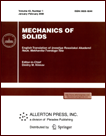 | | Mechanics of Solids
A Journal of Russian Academy of Sciences | | Founded
in January 1966
Issued 6 times a year
Print ISSN 0025-6544
Online ISSN 1934-7936 |
Archive of Issues
| Total articles in the database: | | 13362 |
| In Russian (Èçâ. ÐÀÍ. ÌÒÒ): | | 8178
|
| In English (Mech. Solids): | | 5184 |
|
| << Previous article | Volume 59, Issue 7 / 2024 | Next article >> |
| D.S. Denisevich, "Simulation of Coupled White Layer Formation and Internal Stresses Evolution During Pulsed Thermomechanical Surface Treatment of AISI 1045 Annealed Steel," Mech. Solids. 59 (7), 3818-3830 (2024) |
| Year |
2024 |
Volume |
59 |
Number |
7 |
Pages |
3818-3830 |
| DOI |
10.1134/S0025654424606608 |
| Title |
Simulation of Coupled White Layer Formation and Internal Stresses Evolution During Pulsed Thermomechanical Surface Treatment of AISI 1045 Annealed Steel |
| Author(s) |
D.S. Denisevich (Robotics and Integrated Automation Department, Bauman Moscow State Technical University, Moscow, 105005 Russia, denisevich.d.s@yandex.ru) |
| Abstract |
In this work, a three-dimensional (3D) finite element model is developed to investigate the
coupled thermal, mechanical and the white layer formation phenomena during electromechanical treatment (EMT) of AISI 1045 annealed steel. White layer is frequently mentioned as specific kind of
martensitic structure (untempered martensite). However, through SEM study it was shown that the
white layer which is formed during the EMT has a nonuniform ultra-disperse structure which has
nothing to do with the conventional martensite. The results of numerical based thermal analysis show
that alternating current during the EMT leads to repetitive temperature variations in the surface layer.
As a consequence, a regular inhomogeneous structure is formed with alternating fragments of the
white layer and self-tempered zones with the initial structure. It was found that the white layer has a
dominant effect on the residual stress distribution. The calculation results show that longitudinal
residual stress at the surface varies depending on the white layer volume fraction. More detailed analysis indicates that the stress state close to biaxial compression is formed in the regions corresponding
to white layer fragments. In the areas with a lower white layer volume fraction two principal stresses
are compressive, and the last one with the highest absolute value is tensile. |
| Keywords |
white layer, residual stress, simulation, phase transformation, finite element, heat treatment |
| Received |
19 November 2024 | Revised |
02 December 2024 | Accepted |
03 December 2024 |
| Link to Fulltext |
|
| << Previous article | Volume 59, Issue 7 / 2024 | Next article >> |
|
 If you find a misprint on a webpage, please help us correct it promptly - just highlight and press Ctrl+Enter If you find a misprint on a webpage, please help us correct it promptly - just highlight and press Ctrl+Enter
|
|

 Russian
Russian  English
English